the road map to saving £2,500 a year of your energy bills
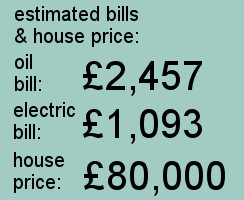
We have used the SAP 2012 software to model the energy performance of a typical 1,100ft², 3 bedroom semi-detached dwelling built before 1985.
The house has the original 65% efficient boiler.
4 inches of loft insulation and 2 inches of polystyrene wall insulation.
There is no floor insulation.
The windows are double glazed. Air leakage is assumed to be the average 12m³.
The oil price has been taken at 60p a litre and electricity at 17p a unit.
The starting EPC is F32
The house has the original 65% efficient boiler.
4 inches of loft insulation and 2 inches of polystyrene wall insulation.
There is no floor insulation.
The windows are double glazed. Air leakage is assumed to be the average 12m³.
The oil price has been taken at 60p a litre and electricity at 17p a unit.
The starting EPC is F32
step 1 - hot water cylinder insulation
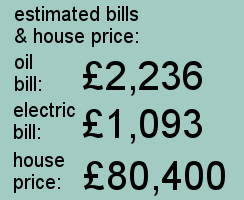
An 80mm thick hot water cylinder insulation jacket costs around £15 and when placed over the existing cylinder insulation should save you at least £50 a year.
You will save even more if you insulate the pipes between the boiler and the cylinder and any pipes around the cylinder. Try to ensure there are no gaps. Pipe insulation costs between £1-2 a meter.
As the hot water in this cylinder is kept above 60°C, the longer you can keep it hot, through better insulation, the more money you will save.
You will save even more if you insulate the pipes between the boiler and the cylinder and any pipes around the cylinder. Try to ensure there are no gaps. Pipe insulation costs between £1-2 a meter.
As the hot water in this cylinder is kept above 60°C, the longer you can keep it hot, through better insulation, the more money you will save.
step 2 - lights
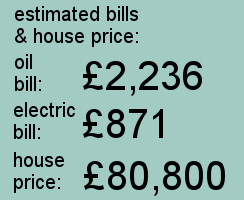
efficient lighting costs £120-£150 & saves £220
Replacing old style incandescent light bulbs or halogen down lighters with LED light fittings will cost between £6 - £16 a fitting.
The savings are made because you are switching from a light using 60 watts of electricity to one using around 5 watts. It means you will be able to run the whole house of one old style light bulb. You may need to change some dimmer switches as well as they cannot operate efficiently at the new low power ratings. A new LED dimmer switch costs between £15-£25.
Savings are generally around £10 a light bulb a year.
Replacing old style incandescent light bulbs or halogen down lighters with LED light fittings will cost between £6 - £16 a fitting.
The savings are made because you are switching from a light using 60 watts of electricity to one using around 5 watts. It means you will be able to run the whole house of one old style light bulb. You may need to change some dimmer switches as well as they cannot operate efficiently at the new low power ratings. A new LED dimmer switch costs between £15-£25.
Savings are generally around £10 a light bulb a year.
step 3 - air sealing
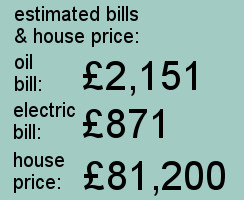
air sealing costs £200-£400 & saves £65-£130
Air leakage will typically make up a third of your heating bill.
Generally air sealing will reduce air leakage by a third.
The average air leakage rate is around 12m³ and savings of around £80 a year should be possible. If your house has a higher air leakage rate, say around 18m³ then the savings will be around £130 a year. Cutting air leakage also reduces the risk of condensation.
The effect of air leakage is probably under estimated by the Energy Model and savings should be in practice greater. It will also have the biggest impact on making your home feel warmer by eliminating draughts.
Air leakage will typically make up a third of your heating bill.
Generally air sealing will reduce air leakage by a third.
The average air leakage rate is around 12m³ and savings of around £80 a year should be possible. If your house has a higher air leakage rate, say around 18m³ then the savings will be around £130 a year. Cutting air leakage also reduces the risk of condensation.
The effect of air leakage is probably under estimated by the Energy Model and savings should be in practice greater. It will also have the biggest impact on making your home feel warmer by eliminating draughts.
step 4 - insulation - attic insulation
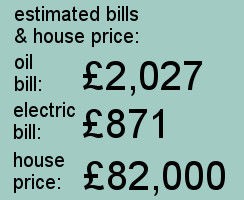
attic insulation costs £400-£600 & saves £120
Remove as much 'stuff' from the attic as you can and ensure existing insulation is laid evenly over the entire ceiling. Insulate the attic hatch and ensure it is draught sealed. Lay 200mm overlay attic insulation evenly over the whole attic. Ensure all joists are covered and all pipe works is also insulated. You may also need to add some roof ventilation. Topping up attic insulation will save you around £120 a year. 200mm overlay insulation costs around £5/m²
Remove as much 'stuff' from the attic as you can and ensure existing insulation is laid evenly over the entire ceiling. Insulate the attic hatch and ensure it is draught sealed. Lay 200mm overlay attic insulation evenly over the whole attic. Ensure all joists are covered and all pipe works is also insulated. You may also need to add some roof ventilation. Topping up attic insulation will save you around £120 a year. 200mm overlay insulation costs around £5/m²
step 4 - insulation - cavity wall insulation
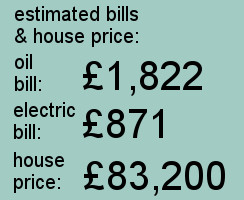
cavity wall insulation costs £2,000 & saves £210
Injecting closed cell polyurethane insulation into the cavity walls will more than double the insulation performance of the external walls & will also improve the air tightness of the dwelling. Improving air tightness will also eliminate draughts and make the house feel warmer.
These two improvements should save around £200 a year.
The foam insulation is around £25/m² to inject into the cavity.
Injecting closed cell polyurethane insulation into the cavity walls will more than double the insulation performance of the external walls & will also improve the air tightness of the dwelling. Improving air tightness will also eliminate draughts and make the house feel warmer.
These two improvements should save around £200 a year.
The foam insulation is around £25/m² to inject into the cavity.
step 5 - mechanical - thermostatic radiator valves
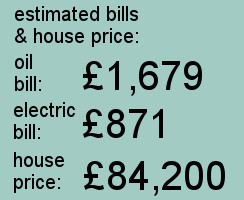
thermostatic radiator valves costs £250 & saves £140
A thermostatic radiator valve (TRV) allows you to control the temperature of a room, by allowing you to set the temperature of each radiator.
Fitting TRV's involves draining down the whole system and replacing the valve on each radiator. Therefore to fit one TRV would probably cost around £100, but replacing 7 TRV's would probably cost around £200.
They should save around 15% of your heating bill.
A thermostatic radiator valve (TRV) allows you to control the temperature of a room, by allowing you to set the temperature of each radiator.
Fitting TRV's involves draining down the whole system and replacing the valve on each radiator. Therefore to fit one TRV would probably cost around £100, but replacing 7 TRV's would probably cost around £200.
They should save around 15% of your heating bill.
step 5 - mechanical - new condensing boiler
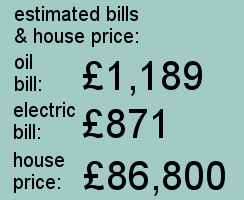
new boiler costs £1500-£1800 & saves £500
If your boiler is from before 1985 it is probably around 70% efficient or less.
New condensing boilers are around 90% efficient meaning that there will be a 20% saving on your oil costs. If you add in Thermostatic Radiator Valves for around £10 a radiator then you should save around £500 a year by replacing your old boiler.
Grants of between £400 and £700 are available for replacing boilers.
If your boiler is from before 1985 it is probably around 70% efficient or less.
New condensing boilers are around 90% efficient meaning that there will be a 20% saving on your oil costs. If you add in Thermostatic Radiator Valves for around £10 a radiator then you should save around £500 a year by replacing your old boiler.
Grants of between £400 and £700 are available for replacing boilers.
step 5 - mechanical - new hot water cylinder thermostat
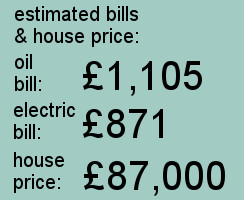
cylinder thermostat costs £300 & saves £85
A cylinder thermostat controls the temperature of the water in the hot water cylinder.
The thermostat should be set at 60°C so that the water is hot enough to kill any harmful bacteria and cool enough to minimise any scalding risk.
A cylinder thermostat costs only around £20.
However fitting it can be expensive as you may also have to fit a motorised valve and link it to the programmer to work most efficiently. Considering that a replacement insulated hot water cylinder will cost around £220 and an immersion heater around £15, it may be cost effective to replace the whole system in one go to get the best return from your plumber's time.
A cylinder thermostat controls the temperature of the water in the hot water cylinder.
The thermostat should be set at 60°C so that the water is hot enough to kill any harmful bacteria and cool enough to minimise any scalding risk.
A cylinder thermostat costs only around £20.
However fitting it can be expensive as you may also have to fit a motorised valve and link it to the programmer to work most efficiently. Considering that a replacement insulated hot water cylinder will cost around £220 and an immersion heater around £15, it may be cost effective to replace the whole system in one go to get the best return from your plumber's time.
option - new windows & doors
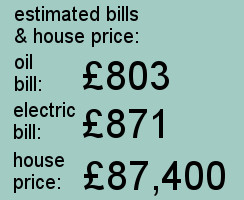
new windows & doors costs £4,000 & saves £300
new double glazed windows & doors will cost £3,500-£4,000.
They will save around £300 a year.
new triple glazed windows & doors will cost £4,200-£4,800.
Triple glazed windows will save £360 a year.
If your existing windows are leaky and cannot be draught sealed then the savings will mbe a lot higher.
New windows and doors, because they have a high aesthetic value may add more to the value of your home than indicated above.
new double glazed windows & doors will cost £3,500-£4,000.
They will save around £300 a year.
new triple glazed windows & doors will cost £4,200-£4,800.
Triple glazed windows will save £360 a year.
If your existing windows are leaky and cannot be draught sealed then the savings will mbe a lot higher.
New windows and doors, because they have a high aesthetic value may add more to the value of your home than indicated above.
step 7 - renewables - photovoltaic panels
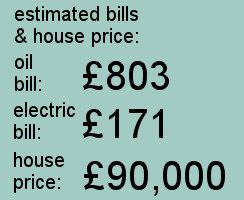
photovoltaic panels cost around £5,500 & saves £700
The roof on average size house will probably limit you to a 3KW photovoltaic installation. The full installation will cost about £5,500 and generate an income of around £700 a year, giving a payback of around 8 years.
The £700 income is guaranteed for 20 years giving you a simple profit of around £8,000 after maintenance costs.
The PV panels are guaranteed to be more than 80% efficient after 25 years and will therefore reduce your electricity bill by around £450 in 2040.
Photovoltaic panels are not to everyone's taste and may not put value on your home.
The roof on average size house will probably limit you to a 3KW photovoltaic installation. The full installation will cost about £5,500 and generate an income of around £700 a year, giving a payback of around 8 years.
The £700 income is guaranteed for 20 years giving you a simple profit of around £8,000 after maintenance costs.
The PV panels are guaranteed to be more than 80% efficient after 25 years and will therefore reduce your electricity bill by around £450 in 2040.
Photovoltaic panels are not to everyone's taste and may not put value on your home.
summary
All the above works would cost around £15,000 and put around £1,080 onto your mortgage. The works would however reduce your energy bills from £3,550 to £974 leaving you £2,576 a year better off. So taking into account your higher mortgage payments you should be around £1,500 a year better off, living in a warm, comfortable home that has increased in value by £10,000.
All values are estimates but the general rule of thumb is that energy efficiency will result in a warmer home, increase the value of your home and the savings from energy bills should pay for the works.
All the above works would cost around £15,000 and put around £1,080 onto your mortgage. The works would however reduce your energy bills from £3,550 to £974 leaving you £2,576 a year better off. So taking into account your higher mortgage payments you should be around £1,500 a year better off, living in a warm, comfortable home that has increased in value by £10,000.
All values are estimates but the general rule of thumb is that energy efficiency will result in a warmer home, increase the value of your home and the savings from energy bills should pay for the works.










